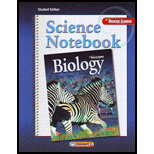
To fill:
Correct terms according to given definitions.
Introduction:
Oceans and water bodies are divided into different regions depending on the distribution of
Answer to Problem 1NV
Given blanks can be filled as follows:
| S. no. | Correct term |
| 1 | Profundal zone |
| 2 | Intertidal zone |
| 3 | Aphotic zone |
| 4 | Photic zone |
| 5 | Abyssal zone |
| 6 | Wetlands |
| 7 | Littoral zone |
| 8 | Estuary |
| 9 | Limnetic zone |
| 10 | Benthic zone |
| 11 | Sediment |
| 12 | Planktons |
Explanation of Solution
Profundal zone: Profundal zone is the deepest zone of any freestandingwater body such as lakes or ponds. Water in this region is generally undisturbed and there is almost no penetration of light.
Intertidal zone: The region where the land and water meet are known as the intertidal zone. It is azone betweenlowest and highest tides. Sometimes it is also referred to as foreshore and seashore.
Aphotic zone: Aphotic means no light, so, an aphotic zone is a region, where sunlight is not able to penetrate. It is below a depth of 200meters (approximately) of an open waterbody.
Photic zone: Photic zone is a region, where sunlight is available. In general, a photic zone is around 200 meters from the surface of a water body. Below 200 meters, sunrays are not able to penetrate water.
Abyssal zone: The abyssal zone of an ocean is the deepest zone. This region is devoid of any light source and organisms living there are adapted to low lights.
Wetlands: Wetlands are areas, in which soil is covered with waterdue to the presence of nearby large bodies. These regions are saturated with water, which supports the growth of some aquatic organisms. Marshes and swamps are different types of wetlands.
Littoral zone: Littoral zone of a water body is a region, where water is present near land. These regions are shallow and support the growth of many aquatic plants.
Estuary: It is a water body where one or more rivers join the sea. An estuary is a partially coveredbody and here, freshwater from the river and salty water from the sea get mixed.
Limnetic zone: Limnetic zone of a water body is a region, which is open and away from the land. In this region, water is generally undisturbed and freestanding and supports the growth of planktons.
Benthic zone: Benthic zone is the lowest level of a water body, which is present near solid bottoms, such as shore, subsurface water, and ocean floor. It is an ecological region, in which sediments, sand, slit, and the dead remains of organisms are present in the sea.
Sediments: Sediments are solid materials that are present in the water body. These sediments in water may come with wind, glaciers, or solid pollutants.
Planktons: Planktons are microscopic free-floating autotrophs. They are one of the major sources of food for smaller aquatic organisms and one of the prime producers in an aquatic ecosystem.
Additional Science Textbook Solutions
Physics for Scientists and Engineers: A Strategic Approach, Vol. 1 (Chs 1-21) (4th Edition)
Microbiology: An Introduction
Campbell Biology (11th Edition)
Anatomy & Physiology (6th Edition)
Organic Chemistry (8th Edition)
Chemistry: An Introduction to General, Organic, and Biological Chemistry (13th Edition)
- What is behavioral adaptarrow_forward22. Which of the following mutant proteins is expected to have a dominant negative effect when over- expressed in normal cells? a. mutant PI3-kinase that lacks the SH2 domain but retains the kinase function b. mutant Grb2 protein that cannot bind to RTK c. mutant RTK that lacks the extracellular domain d. mutant PDK that has the PH domain but lost the kinase function e. all of the abovearrow_forwardWhat is the label ?arrow_forward
- Can you described the image? Can you explain the question as well their answer and how to get to an answer to an problem like this?arrow_forwardglg 112 mid unit assignment Identifying melting processesarrow_forwardGive only the mode of inheritance consistent with all three pedigrees and only two reasons that support this, nothing more, (it shouldn't take too long)arrow_forward
- Oarrow_forwardDescribe the principle of homeostasis.arrow_forwardExplain how the hormones of the glands listed below travel around the body to target organs and tissues : Pituitary gland Hypothalamus Thyroid Parathyroid Adrenal Pineal Pancreas(islets of langerhans) Gonads (testes and ovaries) Placentaarrow_forward
- What are the functions of the hormones produced in the glands listed below: Pituitary gland Hypothalamus Thyroid Parathyroid Adrenal Pineal Pancreas(islets of langerhans) Gonads (testes and ovaries) Placentaarrow_forwardDescribe the hormones produced in the glands listed below: Pituitary gland Hypothalamus Thyroid Parathyroid Adrenal Pineal Pancreas(islets of langerhans) Gonads (testes and ovaries) Placentaarrow_forwardPlease help me calculate drug dosage from the following information: Patient weight: 35 pounds, so 15.9 kilograms (got this by dividing 35 pounds by 2.2 kilograms) Drug dose: 0.05mg/kg Drug concentration: 2mg/mLarrow_forward
 Human Anatomy & Physiology (11th Edition)BiologyISBN:9780134580999Author:Elaine N. Marieb, Katja N. HoehnPublisher:PEARSON
Human Anatomy & Physiology (11th Edition)BiologyISBN:9780134580999Author:Elaine N. Marieb, Katja N. HoehnPublisher:PEARSON Biology 2eBiologyISBN:9781947172517Author:Matthew Douglas, Jung Choi, Mary Ann ClarkPublisher:OpenStax
Biology 2eBiologyISBN:9781947172517Author:Matthew Douglas, Jung Choi, Mary Ann ClarkPublisher:OpenStax Anatomy & PhysiologyBiologyISBN:9781259398629Author:McKinley, Michael P., O'loughlin, Valerie Dean, Bidle, Theresa StouterPublisher:Mcgraw Hill Education,
Anatomy & PhysiologyBiologyISBN:9781259398629Author:McKinley, Michael P., O'loughlin, Valerie Dean, Bidle, Theresa StouterPublisher:Mcgraw Hill Education, Molecular Biology of the Cell (Sixth Edition)BiologyISBN:9780815344322Author:Bruce Alberts, Alexander D. Johnson, Julian Lewis, David Morgan, Martin Raff, Keith Roberts, Peter WalterPublisher:W. W. Norton & Company
Molecular Biology of the Cell (Sixth Edition)BiologyISBN:9780815344322Author:Bruce Alberts, Alexander D. Johnson, Julian Lewis, David Morgan, Martin Raff, Keith Roberts, Peter WalterPublisher:W. W. Norton & Company Laboratory Manual For Human Anatomy & PhysiologyBiologyISBN:9781260159363Author:Martin, Terry R., Prentice-craver, CynthiaPublisher:McGraw-Hill Publishing Co.
Laboratory Manual For Human Anatomy & PhysiologyBiologyISBN:9781260159363Author:Martin, Terry R., Prentice-craver, CynthiaPublisher:McGraw-Hill Publishing Co. Inquiry Into Life (16th Edition)BiologyISBN:9781260231700Author:Sylvia S. Mader, Michael WindelspechtPublisher:McGraw Hill Education
Inquiry Into Life (16th Edition)BiologyISBN:9781260231700Author:Sylvia S. Mader, Michael WindelspechtPublisher:McGraw Hill Education





